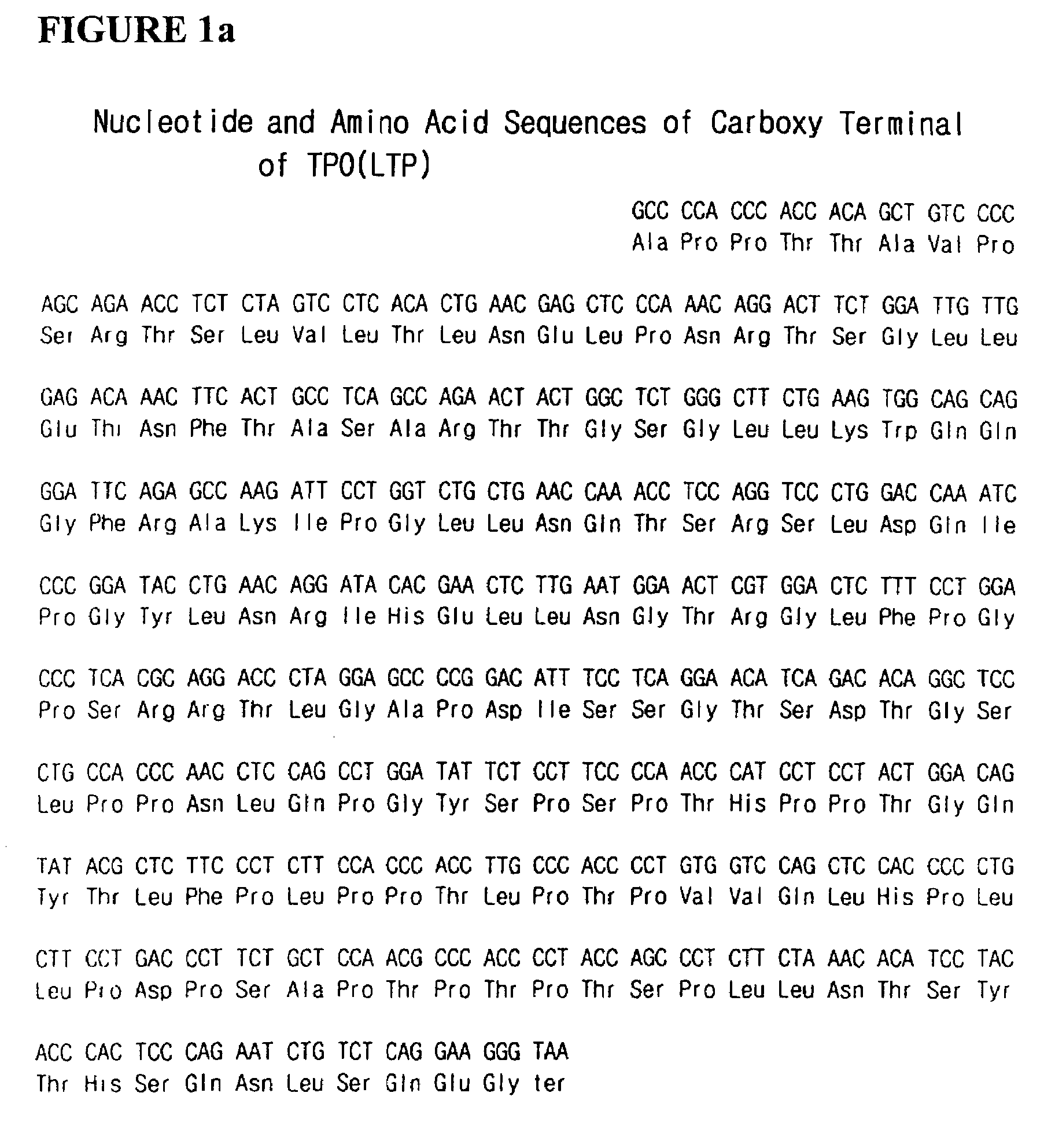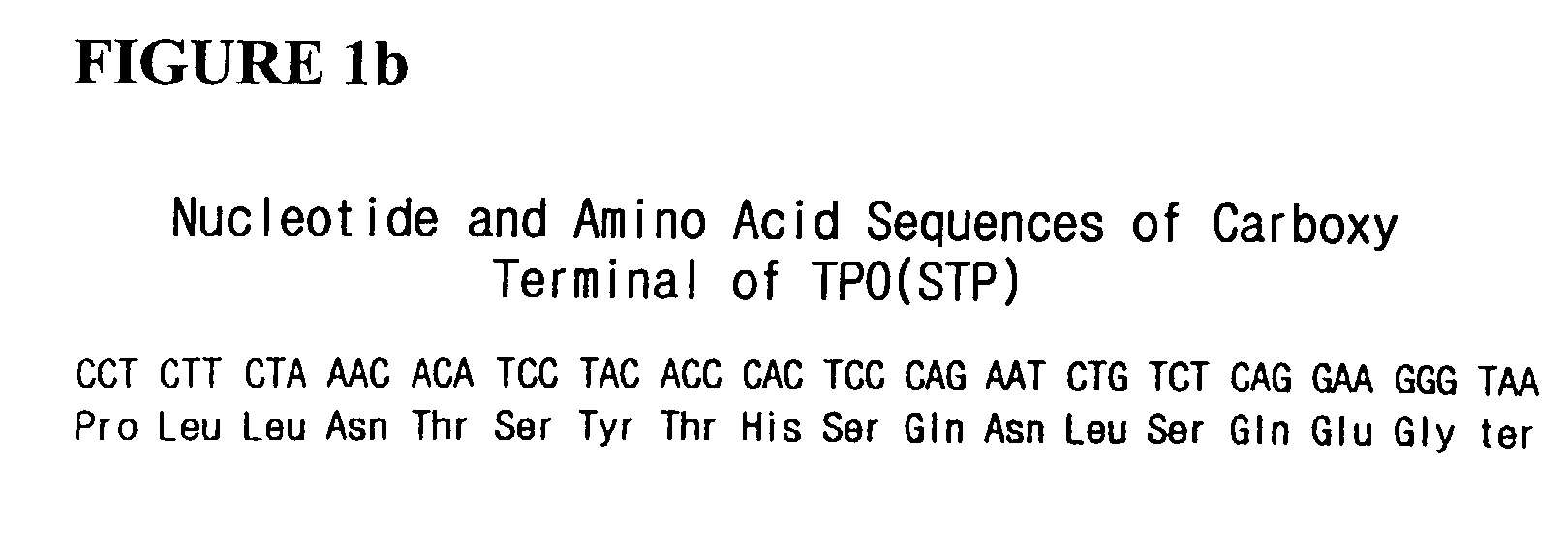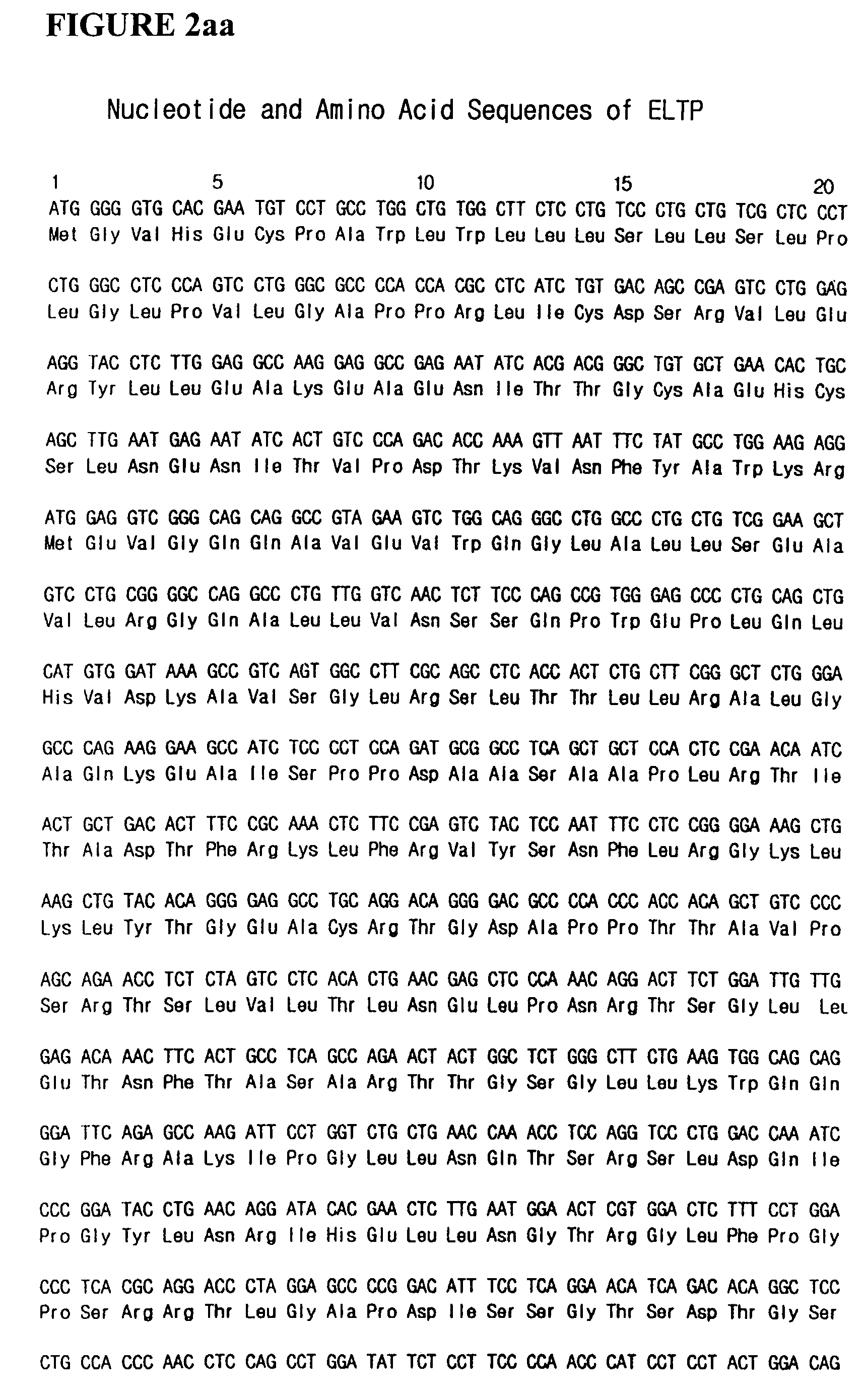Fusion protein having enhanced in vivo activity of erythropoietin
a technology of erythropoietin and fusion protein, which is applied in the direction of disinfection, peptides, drug compositions, etc., can solve the problems of not being able to use all amino acids, peptides or heterogeneous protein fragments for this purpose, and short half-life, etc., to achieve enhanced in vivo half-life, enhanced in vivo activity of epo, and increased carbohydrate content of epo
- Summary
- Abstract
- Description
- Claims
- Application Information
AI Technical Summary
Benefits of technology
Problems solved by technology
Method used
Image
Examples
example 1
Preparation of Gene
[0050]EPO cDNA was obtained by performing the conventional PCR (PCR PreMix Kit of Bioneer Co.) using the primers EP1 and EP2 that are complementary to the terminals of EPO cDNA, in an amount of 50 pmole, respectively, from cDNA library of human-derived fetal liver (Invitrogen Co.). TPO cDNA was obtained using the primers T1 and T2, complementary to the terminals of TPO cDNA, according to the same manner. Total 30 cycles of PCR were performed using high fidelity Taq system of BM Co. under the condition of 52° C. for 40 seconds for annealing, 72° C. for 55 seconds, and 94° C. for 20 seconds to give EPO cDNA and TPO cDNA. They were cloned to pGEM-T (Promega Co.), a cloning vector, respectively. That is, the PCR products were eluted from 1% agarose gel and ligated into pGEM-T, which was then introduced into E. coli NM522. The transformed E. coli was cultivated overnight in LB-ampicillin plate containing X-gal / IPTG. Plasmids were purified from the white colonies and tr...
example 2
Construction of Expression Vectors pcDNA-ELTP and pcDNA-ESTP
[0056]pcDNA3.1 vector of Invitrogen Co. was used as an expression vector. ELTP and ESTP genes that are cloned to pGEM-T vector contain HindIII and BamHI recognition sites at terminals, respectively. pcDNA3.1, pGEM-ELTP and pGEM-ESTP were treated with restriction enzymes, HindIII and BamHI, respectively. The linearized pcDNA3.1, ELTP, and ESTP genes were isolated using Qiagen extraction kit on agarose gel. After ligation of pcDNA3.1 with ELTP or ESTP, the ligation product was introduced into E. coli NM522. Plasmids were isolated from the colonies that had been formed from cultivation of the transformed E. coli in LB-ampicillin plate overnight, and were treated with restriction enzymes, HindIII and BamHI. Colonies having ELTP or ESTP gene were then screened by 1% agarose gel electrophoresis. These plasmids were designated as pcDNA-ELTP and pcDNA-ESTP, respectively (FIG. 3).
example 3
Transformation of CHO Cell and Expression
[0057]CHO cells (DG44) were cultivated to a confluency of 40˜80% (1˜4×105 cells / 60 mm dish) in a 60 mm cell culture dish. 3 μl of superfection reagent (BM Co.) and 97 μl of cell culture medium (α-MEM with media, no serum, no antibiotics) were mixed well, and plasmid pcDNA-ELTP (=0.1 μg / μl, about 2 μg) and vector pLTRdhfr26 (ATCC37295, 0.2 μg) having dhfr gene were added thereto. The mixture was reacted for 5˜10 minutes at room temperature and then added to the cells as prepared above. After one day, the medium was refreshed with a medium containing G418 in an amount of 500 μg / ml (α-MEM without media, 10% FBS). The medium was then refreshed with the G418 medium containing 500 μg / ml of G418 for 7˜10 days, during which cells without G418 resistance gene and negative control cells were completely killed. Selected cells on G418 medium were cultivated sufficiently and an expressed ELTP protein was identified using EPO ELISA kit of BM Co. The same p...
PUM
| Property | Measurement | Unit |
|---|---|---|
| pH | aaaaa | aaaaa |
| pH | aaaaa | aaaaa |
| pH | aaaaa | aaaaa |
Abstract
Description
Claims
Application Information
 Login to View More
Login to View More - R&D
- Intellectual Property
- Life Sciences
- Materials
- Tech Scout
- Unparalleled Data Quality
- Higher Quality Content
- 60% Fewer Hallucinations
Browse by: Latest US Patents, China's latest patents, Technical Efficacy Thesaurus, Application Domain, Technology Topic, Popular Technical Reports.
© 2025 PatSnap. All rights reserved.Legal|Privacy policy|Modern Slavery Act Transparency Statement|Sitemap|About US| Contact US: help@patsnap.com



